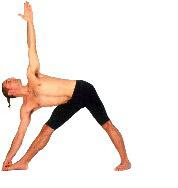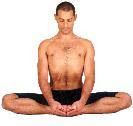The Primary Series : Standing Asanas 5 & 6

V UTTHITA PARSVAKONASANA • EXTENDED SIDE ANGLE POSE Utthita=extended Parsva=side Kona=angle 1. Inhale, jump to right, approximately 4 ft apart, arms out to the sides, left heel turned in, right foot parallel to edge of mat. 2. Exhale, bend right knee over right ankle, extend right arm out as far as possible before placing it on floor outside of the right foot, either palm or finger tips, keep the pelvis tucked, open chest toward ceiling, press right knee into right arm and push on floor with back foot, feeling of being drawn and quartered. Drishti: palm of left hand. Hold for 5-8 breaths. 3. Inhale, come up. 4. Exhale down to other side, repeat 1-3. Modified posture: right elbow on right knee instead of hand to floor, back knee on the floor if necessary. VI PARIVRITTA PARSVAKONASANA • REVOLVING SIDE ANGLE POSE Parivrita=revolved Parsva=side Kona=angle 1. Exhale, turn to right bending right knee directly over right ankle. Bring left elbow on the outsi...






